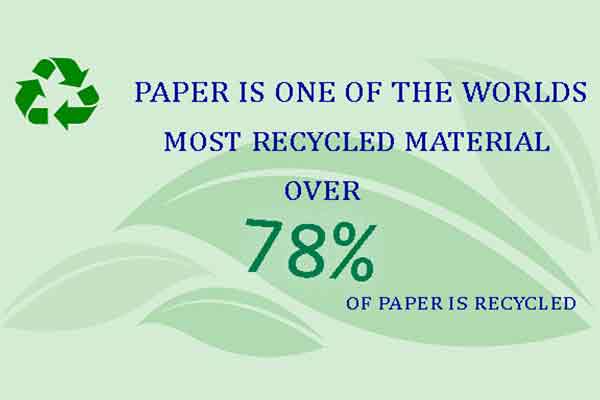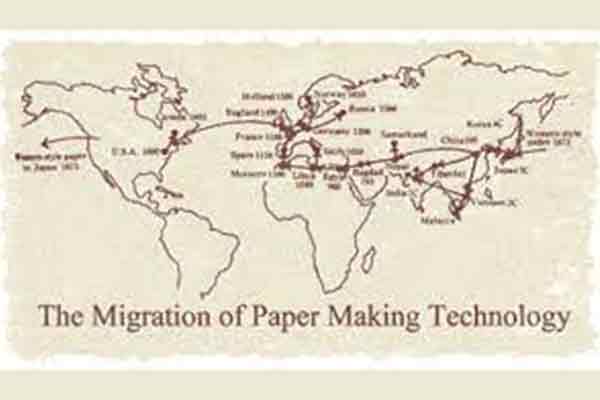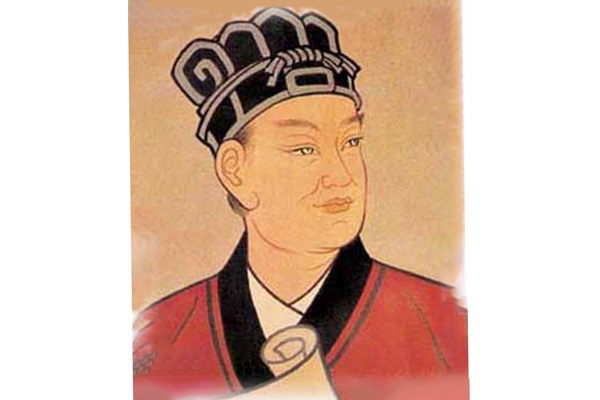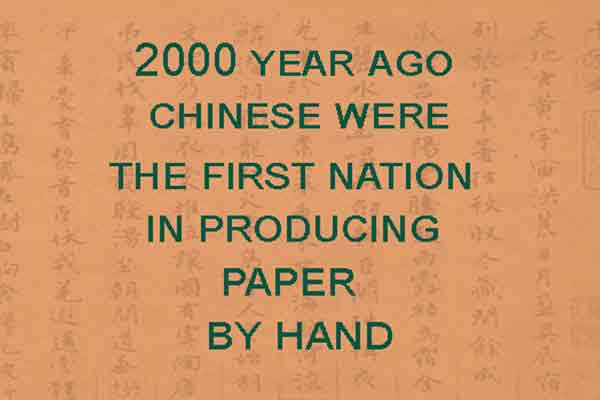Paper Origins & History
Paper has a rich, colorful history which has spanned the world's geography and its cultures. To trace its development offers us insight into humanity's relentless imagination, creativity and sometimes folly.
Thanks to the wonderful creation of paper many descriptions of our world have been stored so that we may share and learn from them. We have prepared the following history of paper, along with a description of how paper is made, what it is used for and some words that are useful to know when talking about paper.
We hope that this is an informative, useful and enjoyable document which inspires you, in the same way that we have been, about paper. We welcome your comments and contributions. Please contact us at anytime.

The Origins of Paper
Egypt 3000 BC
When we think of the origins of paper, our minds might wander back over 5000 years ago to the Nile river valley in Egypt. It was there that a marsh grass called Cyperous Papyrus flourished. The Egyptians cut thin strips from the plant’s stem and softened them in the muddy waters of the Nile. These strips were then layered in right angles to form a kind of mat. The mat was then pounded into a thin sheet and left in the sun to dry. The resulting sheets were ideal for writing on. Since they were also lightweight and portable they became the writing medium of choice of Egyptians, Greeks and Romans for record keeping, spiritual texts and works of art.
It is from papyrus that the word paper comes from. Although papyrus sheets were similar to paper in terms of function, being laminated sheets they were technically more like a mat and therefore not the same as the papers of today. Similar processes were developed in other lands – in Central America during the 2nd Century AD the Mayans fashioned a similar product for bookmaking. In the Pacific Islands, a paper was made by beating a fine bark over specially shaped logs to make clothes and ritual objects. However, none of these sheets would qualify as true paper today.
The father of true paper T’sai Lun
Paper as we know it today comes from another source – China. Excavations of tombs of the former Han Dynasty (207BC-9AD) have revealed silk cloth bearing the texts of Lao Tzu – the father of Taoism (born in 604BC). In 105 AD, Han Emperor Ho-Ti’s chief eunuch T’sai Lun experimented with a wide variety of materials and refined the process of macerating the fiber of plants until each filament was completely separate.

Spread of Papermaking
A Million Prayers
It wasn’t until the 3rd century that the secret art of papermaking began to creep out of China, first to Vietnam and then Tibet. It was introduced in Korea in the 4th century and spread to Japan in 6th.
There, during the 8th century, the Empress Shotuka undertook a massive project consisting of printing a million prayers – dharani – on individual sheets of paper, with each mounted in its own pagoda. With such a profound inception, it is not surprising that the fine art of papermaking has continued in Japan to this day, garnering deep appreciation and ever increasing sophistication.
The Journey to the West
Papermaking spread slowly throughout Asia to Nepal and later to India. It made its true push westward in 751AD when the Tang Dynasty was at war with the Islamic world. During a battle on the banks of the Tarus river, Islamic warriors captured a Chinese caravan which happened to include several papermakers. They spirited them away to Samarkand, which soon became a great centre for paper production.
Gradually papermakers made their way further west through the Muslim world – to Baghdad, Damascus and Cairo. Finally, when the Moors from North Africa invaded Spain and Portugal they brought the technology with them and so it was that papermaking entered Europe in the 12th century.

Spreading the Word
In Europe, the use of papyrus had dropped out in the 9th century. The preferred medium for the artists and literati of the time was the smooth and lustrous parchment. However, parchment – made from animal skin – was extremely expensive. In fact, it has been estimated that a single bible hand written on parchment required the skins of 300 sheep.
The notion of paper being used as a practical everyday item did not occur until the 15th Century. When Johann Gutenburg perfected movable type and printed his famous bible in 1456, he not only spread the word of Christianity, but also sparked a revolution in mass communication. The birth of the modern paper and printing industry is commonly marked from this date.
Paper Becomes an Industry
The Age of Experimentation
Printing technology rapidly developed and created an ever increasing demand for paper. The early European papers were made from recycled cotton and linen – and a huge trade quickly developed around the trading of old rags. It is said that the black plague entered England from Europe on these old rags.
Yet soon this source became insufficient and some curious attempts were made to source new materials – the most macabre of which was the recycling of Egyptian mummies to create wrapping paper! Others experimented with fibers such as straw, cabbage, wasp nests and finally wood, resulted in inexpensive – and replaceable – materials for paper making. Today, the long soft fibers of softwoods such as spruce have become the most suitable source of pulp for mass production.
Mass Production
The demand for paper also created the need for greater efficiency in production. In the late 18th century the labors of Nicholas Luis Robert resulted in the creation of a machine that could produce a seamless length of paper on a endless wire mesh with squeeze rollers at one end. Perfected and marketed by the Fourdrinier brothers, the new machine made papers soon replaced traditional single sheets made by hand.
In Europe and America, the mass-production of paper became a thriving industry supplying huge volumes of paper for the production of newspapers, books, magazines, paper bags, toilet paper, money and a huge variety of other purposes – including clothing, chimney’s and even coffins! Today, the increasing volume of paper consumption has become a complex environmental matter – and the need for new materials increasingly urgent. While recycling has done some good, much paper is still wasted.
The Future of Paper
Looking Ahead
Owing to the ceaseless imagination of humanity, the words you are reading at this moment are digitally arranged and sent across the world via a new technology – signaling a new revolution in mass communication. As these new technologies develop where does the future of papermaking lay? At HQ Papermaker we believe it lies in the past, when paper was valued for its innate sensual qualities – an appreciation which deeply respects the materials used, the skill of the artisan and the unique quality of the finished product.

Return to Tradition
In the west, as industrial paper production boomed the art of hand paper-making has been driven nearly to extinction – being practiced only by a few fine artists and crafts people. However, in small areas throughout Asia, the tradition has lived on.
Incidentally, the traditional Asian paper which is often referred to as “rice paper” is not made from rice fibers at all. More commonly it is made from the versatile mulberry tree – varieties of which are also used for feeding silkworms and in medicine. In contrast to the cold precision and standardization which industrial production demands, the soft, subtle textures and natural feeling of handmade paper is said to echo the warm heart of the papermaker who makes each sheet with devotion.







